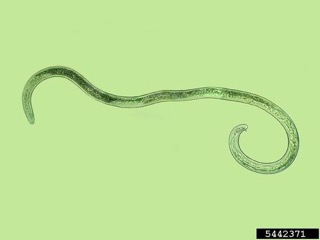Meloidogyne Incognita: Difference between revisions
| Line 33: | Line 33: | ||
Root-Knot Nematodes can be found in the soil worldwide, thriving especially in areas where the climate is hot with winters that are short and not severe drops in temperature. Greenhouses make for the perfect area for these Nematodes to reproduce.[4] Male nematodes move throughout the soil and leave the roots of a plant to go and obtain nutrients. Female's however, stay in a certain area of the root and feed there their whole life until it is time to reproduce. Once they are big enough to reach the top of the root surface, they lay their eggs in the soil. These nematodes are endogeic, meaning they spend their whole lives in the soil.[2] | Root-Knot Nematodes can be found in the soil worldwide, thriving especially in areas where the climate is hot with winters that are short and not severe drops in temperature. Greenhouses make for the perfect area for these Nematodes to reproduce.[4] Male nematodes move throughout the soil and leave the roots of a plant to go and obtain nutrients. Female's however, stay in a certain area of the root and feed there their whole life until it is time to reproduce. Once they are big enough to reach the top of the root surface, they lay their eggs in the soil. These nematodes are endogeic, meaning they spend their whole lives in the soil.[2] | ||
== The Stylet & | == The Stylet & Its Purpose == | ||
Revision as of 08:09, 18 April 2025
Taxonomy
| Domain | Kingdom | Phylum | Class | Order | Family | Genus | |
|---|---|---|---|---|---|---|---|
| Classification | Eukaryota | Animalia | Nematoda | Chromadorea | Tylenchida | Heteroderidae | Meloidogyne |
The Taxonomy of the Meloidogyne Incognita also commonly called Root-Knot Nematodes [1]

Appearance & Life Cycle
Root-Knot Nematodes have multiple juvenile stages in their lifetime. In their earliest juvenile forms, male and female nematodes are vermiform, meaning they appear like skinny worms. These nematodes grow through molting and shedding their outer layer to allow them to increase in size. Adult males keep the worm shape, whereas females grow into a more spherical shape as they grow. These nematodes grow to be 1/10 the size of a pinhead and are too small to be seen by the human eye, they're also transparent. Females plant their eggs at the root surface in the soil.[2]
Habitat
Root-Knot Nematodes can be found in the soil worldwide, thriving especially in areas where the climate is hot with winters that are short and not severe drops in temperature. Greenhouses make for the perfect area for these Nematodes to reproduce.[4] Male nematodes move throughout the soil and leave the roots of a plant to go and obtain nutrients. Female's however, stay in a certain area of the root and feed there their whole life until it is time to reproduce. Once they are big enough to reach the top of the root surface, they lay their eggs in the soil. These nematodes are endogeic, meaning they spend their whole lives in the soil.[2]